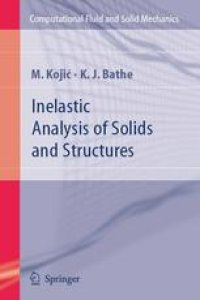
Ebook: Inelastic Analysis of Solids and Structures
- Tags: Continuum Mechanics and Mechanics of Materials, Structural Mechanics, Mechanics
- Series: Computational Fluid and Solid Mechanics
- Year: 2005
- Publisher: Springer-Verlag Berlin Heidelberg
- Edition: 1
- Language: English
- pdf
This book presents computational procedures for the stress integration of inelastic constitutive relations within the incremental-iterative finite element analysis and general strain-driven problems of solids and structures. The book gives the physical and theoretical foundations of inelastic material models commonly used in engineering practice, and focuses on the formulation of robust, efficient and accurate computational algorithms for the response solution of 2-D and 3-D solids, shells, and beam and pipe structures. The algorithms are based on the concept that the implicit stress integration can frequently be reduced to the solution of a single nonlinear equation (an equation for a governing parameter). Many solved engineering examples illustrate the effectiveness of the computational procedures and elucidate inelastic material behavior. The computational schemes can be used for further developments of stress integration algorithms in topics of inelastic material modeling not included in the book.
This book presents computational procedures for the stress integration of inelastic constitutive relations within the incremental-iterative finite element analysis and general strain-driven problems of solids and structures. The book gives the physical and theoretical foundations of inelastic material models commonly used in engineering practice, and focuses on the formulation of robust, efficient and accurate computational algorithms for the response solution of 2-D and 3-D solids, shells, and beam and pipe structures. The algorithms are based on the concept that the implicit stress integration can frequently be reduced to the solution of a single nonlinear equation (an equation for a governing parameter). Many solved engineering examples illustrate the effectiveness of the computational procedures and elucidate inelastic material behavior. The computational schemes can be used for further developments of stress integration algorithms in topics of inelastic material modeling not included in the book.
This book presents computational procedures for the stress integration of inelastic constitutive relations within the incremental-iterative finite element analysis and general strain-driven problems of solids and structures. The book gives the physical and theoretical foundations of inelastic material models commonly used in engineering practice, and focuses on the formulation of robust, efficient and accurate computational algorithms for the response solution of 2-D and 3-D solids, shells, and beam and pipe structures. The algorithms are based on the concept that the implicit stress integration can frequently be reduced to the solution of a single nonlinear equation (an equation for a governing parameter). Many solved engineering examples illustrate the effectiveness of the computational procedures and elucidate inelastic material behavior. The computational schemes can be used for further developments of stress integration algorithms in topics of inelastic material modeling not included in the book.
Content:
Front Matter....Pages I-XI
Introduction....Pages 1-11
An Introduction to the Incremental-Iterative Solution of Nonlinear Structural Problems....Pages 13-35
Fundamental Notions of Metal Plasticity....Pages 37-104
A General Procedure for Stress Integration and Applications in Metal Plasticity....Pages 105-200
Creep and Viscoplasticity....Pages 201-261
Plasticity of Geological Materials....Pages 263-319
Large Strain Elastic-Plastic Analysis....Pages 321-366
Back Matter....Pages 367-414
This book presents computational procedures for the stress integration of inelastic constitutive relations within the incremental-iterative finite element analysis and general strain-driven problems of solids and structures. The book gives the physical and theoretical foundations of inelastic material models commonly used in engineering practice, and focuses on the formulation of robust, efficient and accurate computational algorithms for the response solution of 2-D and 3-D solids, shells, and beam and pipe structures. The algorithms are based on the concept that the implicit stress integration can frequently be reduced to the solution of a single nonlinear equation (an equation for a governing parameter). Many solved engineering examples illustrate the effectiveness of the computational procedures and elucidate inelastic material behavior. The computational schemes can be used for further developments of stress integration algorithms in topics of inelastic material modeling not included in the book.
Content:
Front Matter....Pages I-XI
Introduction....Pages 1-11
An Introduction to the Incremental-Iterative Solution of Nonlinear Structural Problems....Pages 13-35
Fundamental Notions of Metal Plasticity....Pages 37-104
A General Procedure for Stress Integration and Applications in Metal Plasticity....Pages 105-200
Creep and Viscoplasticity....Pages 201-261
Plasticity of Geological Materials....Pages 263-319
Large Strain Elastic-Plastic Analysis....Pages 321-366
Back Matter....Pages 367-414
....